![]()
![]()
![]()
Use LEFT and RIGHT arrow keys to navigate between flashcards;
Use UP and DOWN arrow keys to flip the card;
H to show hint;
A reads text to speech;
73 Cards in this Set
- Front
- Back
|
What are the three tenets of cell theory? |
1. All living things are composed of cells or parts of cells. 2. Cells are the smallest unit of living organisms. 3. Cells come from other cells. |
|
|
Why do cells remain small? |
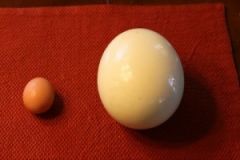
Cells remain small for metabolic efficiency.
- To transport material through the entire cell - and remove waste from entire cell. |
|
|
What three things do all cells contain? |
Plasma Membrane, Cytoplasm, and Nucleus (or Nucleoid Region in prokaryotes). |
|
|
What do we commonly know of as being prokaryotic cells? |
The domains Bacteria and Archaea. |
|
|
What are the general characteristics of prokaryotic cells? |
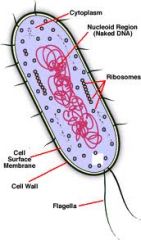
- Simplest organisms. - Ubiquitous (found everywhere) - Metabolically diverse. - Plasma Membrane - surrounds cytoplasm. - No distinct interior compartments. - Contains ribosomes. |
|
|
How do prokaryotic cells differ from eukaryotic cells? |
Prokaryotic cells have no nucleus (have a nucleoid region), have no organelles, are very small, and are very simple.
Eukaryotic cells have a nucleus, have organelles, larger cells, and are more complex. |
|
|
How is the DNA arranged in a prokaryotic cell and where is it found? |
The Genomic DNA forms a single loop that is contained in the nucleoid region. |
|
|
What is a Plasmid? Why are they important? what type of cell are they found in? |
- Plasmids are small loops of independently replicated DNA. - Plasmids can confer traits - R Plasmids confer resistance to antibiotics. - Prokaryotic cells. |
|
|
What distinguishes a prokaryotic cell from a eukaryotic cell? |
Prokaryotic cells have no nucleus (nucleoid region), no organelles, and are very small and very simple.
Eukaryotic cells have a nucleus, have organelles, and are larger and more complex. |
|
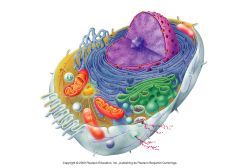
What is the big purple thingy? |
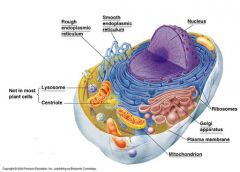
The Nucleus! Woohoo! |
|
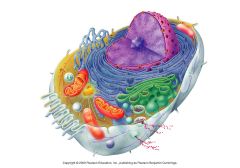
what are the green thingies in the bottom right? |
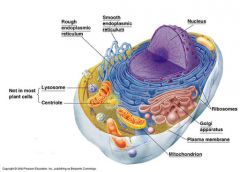
Golgi Apparatus. Look weird, huh? |
|
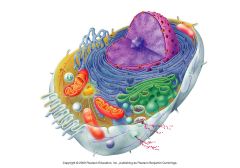
What are the little red/yellowy things at the bottomish area of the cell? |
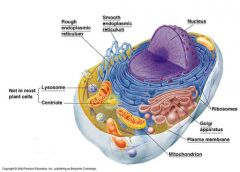
Mitochondrian! Look like peanuts. |
|
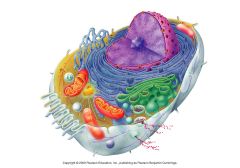
What are the long purply things surrounding the big circle things? |

The Rough ER (Endoplasmic Reticulum). Might need an ER if i have to say that again. |
|
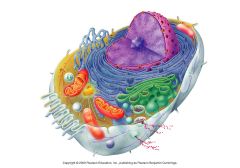
What's the bright yellow thing up against the peanut looking red dealio? |
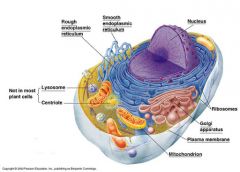
That there would be a centriole! Wouldn't have guessed |
|
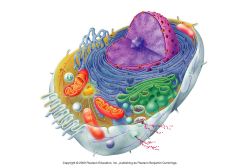
What is the awkward blue thing on the left of the red peanut dealio? |
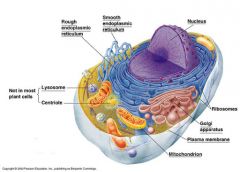
That is a lysosome. Funny little blob, ain't it? |
|

What is the outer layer thing that surrounds the cell? |

The Plasma Membrane |
|
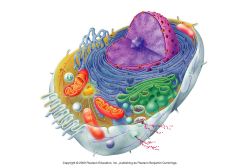
What are the little dot things in the cell that you really can't see at all? |
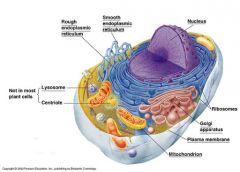
Ribosomes! |
|
|
What molecules make up the plasma membrane? |
Lipid Bilayer (two layers of phospholipids) Embedded Proteins. Glycolipids (carbohydrates joined to lipid) Glycoproteins (carbohydrates joined to proteins) Cholesterol |
|
|
What is the difference between extracellular and intracellular fluid? |
IIntracellular fluid is found between the two layers of the plasma membrane of a cell.
Extracellular fluid is outside of the cell. |
|
|
What is the structure of the plasma membrane? |
Composed of a lipid bilayer, embedded proteins, glycolipids, glycoproteins, and cholesterol.
Fluid mosaic model - phosopholipids drift within the bilayer, "mosaic" of proteins scatter within the bilayer. |
|
|
What is the function of the plasma membrane? |
Functions to control the flow of substances across it. |
|
|
What is the structure of the nucleus? |
Contains Nucleoplasm (semi-fluid medium w/i the nucleus), Genetic Material (Chromatin - DNA plus proteins), Nucleolus (assembles ribosome subunits), and Nuclear Envelope/Membrane (enclose the nucleoplasm, doubly membrane with pores, continuous with ER) |
|
|
What is the function of the nucleus? |
Separates DNA from cytoplasm. |
|
|
What does the Nucleus do? |
Separate DNA from the cytoplasm. |
|
|
What is the definition of NUCLEOPLASM? |
Semifluid medium within the nucleus. |
|
|
What is the definition of CHROMATIN? |
DNA plus proteins.
Chromatin has to do with genetic material. |
|
|
What is the definition of NUCLEOLUS? |
Assembles ribosome subunits. |
|
|
What is the definition of the NUCLEAR ENVELOPE/MEMBRANE? |
- Encloses nucleoplasm. - Double membrane with pores. - Continuous with Endoplasmic Reticulum. |
|
|
What are two things you need to know about the nuclear envelope? |
- It is a double membrane. - It is continuous with the Endoplasmic Reticulum via nuclear pores. |
|
|
What is the structure of a ribosome? |
RNA-protein complexes composed of two subunits. Assembled in nucleoli. |
|
|
What is the function of ribosomes? |
Site of protein synthesis. |
|
|
What are ribosomes composed of? |
RNA. |
|
|
Where are ribosomes located in the cell? |
They are often "free" in the cytoplasm or bound to the Endoplasmic Reticulum (ER). |
|
|
What is the structure of the Endomembrane System? |
Made of of the Endoplasmic Reticulum, which is made of the Rough ER, the Smooth ER, and the Golgi Apparatus (body). |
|
|
What is the function of the Endomembrane System? |
Compartmentalizes the cell, channeling passage of molecules through cell's interior. |
|
|
What organelles make up the Endomembrane System? |
Rough ER, Smooth ER, and Golgy Apparatus (body) |
|
|
What is the function of the Rough ER (Endoplasmic Reticulum)? |
Secretory proteins are packaged in transport vesicles that carry them to their next stage. |
|
|
What is the role of the Rough ER in secretory proteins? |
Secretory proteins are produced within the RER. They are then packaged in transport vesicles that carry them to the next stage. |
|
|
What is the path of a secretory protein within the Rough ER? |
Ribosomes have a role in produces secretory proteins and membrane bound proteins.
Polypeptides thread into the RER.
The secretory proteins are then packaged in transport vesicles, which then carry them to the next stage. |
|
|
What is the function of the Smooth ER (Endoplasmic Reticulum)? |
Plays a role in a variety of metabolic processes.
- Stores calcium ions in muscle cells. - Enzymes help to detoxify poisons in the liver - Synthesize lipids (oils, phospholipids, and steroids) |
|
|
What is different between the Rough ER and the Smooth ER? |
The Rough ER is associated with protein production, folding, and transport. The Smooth ER is associated with production and metabolism of fats and steroid hormones.
The Rough ER is studded with ribosomes, the Smooth ER is not. |
|
|
In what way does the Smooth ER function? |
By storing calcium ions in muscle cells, enzymes help detoxify poisons in the liver, and by synthesizing lipids (oils, phospholipids, and steroids). |
|
|
What is the function of the Golgi Apparatus? |
Center of manufacturing, warehousing, sorting, and shipping. - Sorts and packages materials into transport vesicles. - Many transport vesicles from the ER travel to the Golgi Apparatus for modification of their contents. |
|
|
What is the structure of the Golgi Apparatus? |
Consists of flattened membranous sacs -- cisternae -- looks like a stack of pancakes. |
|
|
What is a lysosome? |
A vesicle containing digestive enzymes that break down food/foreign particles.
Contain digestive enzymes that break down substances. |
|
|
What is a vacuole? |
Food storage and water containers. |
|
|
What is the structure of the Mitochondria? |
Double membrane. Intermembrane space. Matrix. Cristae (folds of inner membrane, location of ATP production). |
|
|
What is the function of the Mitochondria? |
Sites of cellular respiration (ATP synthesis) Harvest chemical energy from food Store energy in form of ATP |
|
|
What does the Mitochondria contain? |
Its own circular DNA. |
|
|
What is the site of cellular respiration? |
The Mitochondria. |
|
|
What is cellular respiration? |
Produces ATP for the energy needs of the cell. |
|
|
What is special about the Mitochondria membrane? |
It's a double membrane! |
|
|
What is the matrix in the Mitochondria? |
The inner fluid-filled space. |
|
|
What is the cristae in the Mitochondria? |
Inner Membrane. |
|
|
What is the function of the Cytoskeleton? |
- Structural Support - Cell shape and anchor - Movement of organelles - Cell locomotion |
|
|
What is the structure of Cytoskeleton? |
- Network of filaments and tubules. - Extend from the nucleus to the plasma membrane. |
|
|
What is the structure of centrioles? |
Short cylinders. |
|
|
What may centrioles be involved in? |
Microtubule formation and disassembly during cell division. |
|
|
What is the function of flagella and cilia? What is their structure? |
Involved in cell movement.
Cilia = small and numerous Flagelle = large and single
|
|
|
What is the function of cell junctions? |
Functions to connect cells to cells. |
|
|
What are the three types of cell junctions? |
Tight junctions. Adhering junctions. Gap junctions. |
|
|
What is a tight junction? |
- Form continuous seals - Leak proof - Prevent infection |
|
|
What is an adhering junction? |
- Rivet cells together and to ECM - Very strong |
|
|
What is a gap junction? |
- Channels link neighbors - Let small molecules & ions move directly from cell to cell. |
|
|
What is plasmodesmata? |
Attaches cells to neighbors. |
|
|
In what type of cell are plasmodesmata located? |
Only in plant cells. |
|
|
What is the function of the Cell Wall? |
- Protection - Maintain cell shape - Plasmodesmata (attaches cell to neighbors) |
|
|
What is the function of the Central Vacuole? |
- Digestive enzymes - Stores chemicals or wastes - Helps grow cell |
|
|
What is the function of Chloroplasts? |
Site of photosynthesis. |
|
|
What is the structure of Chloroplasts? |
- Two outer membranes - Stroma - Thylakoids (third membrane, flattened looking discs)
|
|
|
In what way do plant cells differ from animal cells? |
Animal Cells: - No cell wall, centrioles, small vacuoles
Plant Cells: - Cell wall, large central vacuole, plasmodesmatas, no centrioles |
|
|
What is Endosymbiont Hypothesis? |
Chloroplasts formed from a symbiotic relationship with an early photosynthetic cell and an early eukaryotic cell. |
|
|
What is the evidence Endosymbiont Hypothesis? |
Size similar to prokaryotic cells. Contains DNA. |

